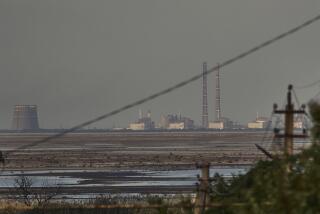Public Trial Set for Chernobyl Officials
- Share via
CHERNOBYL, Soviet Union — A public trial has been scheduled next month for three former top managers accused of responsibility for the world’s worst nuclear accident at Chernobyl reactor No. 4, Mikhail Umaetz, the current director of the atomic power station, announced to a visiting group of foreign journalists.
Umaetz said that a large group of foreign reporters will be accredited to cover the trial, to be held here in Chernobyl, about 11 miles south of the site of the disaster.
“I think it will bring the truth to the whole world,” Umaetz said of the trial. The former director of the plant, its former chief engineer and the former assistant chief engineer will be tried, he said. No details of charges against them were made public.
At least 31 people died as a result of the Chernobyl explosion and fire April 26, 1986, and a cloud of radiation spread over large areas of Europe. About 135,000 people were evacuated from their homes to avoid radiation sickness and resettled beyond an 18-mile radius from the plant.
Soviet authorities have said that a series of blunders by reactor operators, including the shut-off of automatic shutdown systems, caused the accident, which had worldwide reverberations.
Play About the Disaster
A play written about the disaster by a Soviet journalist pictures the director of the plant as a man more interested in evacuating his own grandchildren than protecting the population of Pripyat, a city of 50,000 where plant workers and their families lived.
The city was not evacuated until nearly 36 hours after the blast and release of radioactivity. Soviet officials have defended the delay on grounds that radiation levels had not risen to dangerous levels on the first day after the explosion and fire.
The names of the three former officials to be tried were not made available, but in a June, 1986 report, the Communist Party newspaper Pravda identified the director as V. Bryukhanov and the chief engineer as N. Fromin and said both had been fired. Soviet newspapers have reported previously that four other senior officials at the Chernobyl plant were fired after the accident and more than 70 people working there were stripped of membership in the Communist Party for misconduct, including cowardice.
In previous discussion of the case, however, Soviet authorities have indicated that lower-level officials at the plant were conducting an experiment as reactor No. 4 was nearing a regular shutdown for maintenance.
Last March, Chairman Andronik M. Petrosyants of the State Committee for Utilization of Atomic Energy said a trial would be conducted in the Ukrainian capital of Kiev, 60 miles south of Chernobyl, of those responsible for the Chernobyl catastrophe.
A More Dramatic Dateline
The choice of Chernobyl for the site of the trial, however, will provide a more dramatic dateline for accounts of the trial.
Reporters visiting Chernobyl late last week found some signs of decontamination work more than a year after the accident. Trucks sprayed water on streets in the city and crews of workers spread new topsoil on a central square where contaminated dirt had been removed.
The workers, however, did not wear individual radiation-measuring devices or wear face masks to protect themselves.
At the power station itself, however, greater precautions were still in effect. Nearly everyone outside the facility wore a white face mask and kept his head covered. Individual badges for recording exposure to radioactivity were more widely, but not universally, worn.
Umaetz said, however, that the damaged reactor is now completely sealed by a concrete shell and could not possibly leak any more radioactive substances.
Some Hot Spots Remain
Even so, measuring instruments indicated that there are some hot spots inside the so-called “sarcophagus,” with readings of 1,000 rems per hour, or about half the readings just after the accident, Soviet officials said.
Exposure to 200 rems of radiation is considered “very dangerous” for human beings, Soviet officials said. But they added that readings outside the abandoned reactor are about seven milliroentgens per hour, far above normal background radiation but not threatening to life.
Umaetz said reactor No. 3, which was under the same roof as the destroyed reactor No. 4 and shared some facilities with it, would be decontaminated and put back into operation in September.
The first and second units at the four-reactor complex already have been put back in service, with safety modifications to assure there can be no repetition of the Chernobyl disaster, he said.
More to Read
Sign up for Essential California
The most important California stories and recommendations in your inbox every morning.
You may occasionally receive promotional content from the Los Angeles Times.










